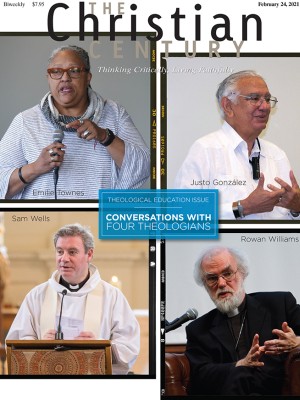March 7, Lent 3B (John 2:13-22)
As Jesus overturns the tables, I imagine John in the corner, watching and taking it all down.
I’m a lover of words, and I have long loved the Gospel of John. I am struck every time I read the strange and wonderful opening line of this strange and wonderful book: “In the beginning was the Word.” There is much in this book to know and to ask about Christ, the Word become flesh. And yet, reading through the second chapter now, my wonder turns to John, the man of words writing Christ as the Word. It is John as reader, writer, and interpreter of Jesus who fills the pages of the sacred text for me today.
The historical facts of John’s life are not settled. Is he the apostle and personal friend of Jesus or an Ephesian elder who followed Jesus at a greater distance? Is he an embodied voice of a whole community or school of thought that we might now call Johannine? Is he a literary symbol or a textual device? The text doesn’t clarify this, but it does invite readers into a “mind at work,” to borrow language from Michael Card, the internal world of a man, real or imagined, engaged in interpretation as a profound practice of faith.
Read our latest issue or browse back issues.
As this week’s reading begins, I am immersed in a suspenseful narrative. I enter the temple with Jesus, pulled along by John’s storytelling and my own imagination. There are stalls of cattle and sheep and cages of doves waiting to become sacred sacrifices to God. There are vendors, money changers, and crowds of customers doing the business of sacrifice. In response to all of this, Jesus takes up a posture of resistance. He acts swiftly, disrupting the profane and abusive business that has overwhelmed the sacred space of the temple. The cattle and the sheep flee, coins fall to the floor, tables crash, and Jesus speaks his protest: “Stop.”
But at this point, there is a shift. The tone, the pace, even the purpose of the passage change in a single moment. The noise of the busy temple and this famous act of righteous anger go still, and I feel the authorial hand of John redirecting the narrative, making space out of all that action for what is, at least for him, the more interesting drama: what all of this must mean. It is this search for meaning that shapes John’s writing in the rest of the scene.
Acts of interpretation are piled atop each other in the text that follows. First, the disciples try to make sense of the incident by turning to the ancient text, recalling the zeal of Psalm 69:9 to explain the zeal of Jesus in this temple scene. Then “the Jews” try to make sense of the incident by questioning Jesus’ actions and his radical closing words, which will later be used to charge him with crimes punishable by death on the cross. “Destroy this temple,” he says, “and in three days I will raise it up” (v. 19). While the crowd responds to these words with understandable confusion—the absence of meaning—John steps into the scene, more fully present than he has been up to this point, and offers the final interpretation in the text. From a unique interpretive posture, looking backward from the crucifixion and the resurrection that have yet to come, John offers a strange new interpretation in strangely matter-of-fact terms: “But he was speaking of the temple of his body.”
Much has been and should be said about this interpretive moment, about the shift from the temple to Christ’s body, about the surety that distinguishes John’s words from the interpretations that precede his. But it is John’s call more than his confidence that strikes me.
John seems to call out to me to join the faith-making craft of interpretation he has just modeled. He calls me to interpret as he has done, with the benefit of his hindsight and my own, but he also calls me, more broadly, to the practice of interpretation itself, to a reading posture that puts my mind at work. As an engaged reader, I can read the sacred text closely and contextually as the disciples do. I can ask questions, even skeptical questions, as “the Jews” do. I can seek new, even radically transformative understanding as John does.
I meet Jesus through John in this Gospel story. That is clear. There is no attempt at objectivity, at the fiction of an unmediated divine voice. There is instead a man offering me his account, his interpretation of this radical thrower of tables, this righteous and angry Word made flesh. And there is, I think, a powerful invitation to step into the demanding, humbling, and creative work of reading this text. New Testament scholar Adele Reinhartz describes John’s Gospel as a site for “the reader’s creative activity in making sense of and responding to the story.” So I read again. I enter the temple with Jesus again. I see the money changing hands. I hear the crash of protest. I imagine John in the corner, taking it all down, writing and rewriting this strange scene until it makes perfect, even simple sense to him. But this time, I also see myself, peering in and speaking back, asking questions and whispering my own remembered words, a creator-interpreter of the story before me.






